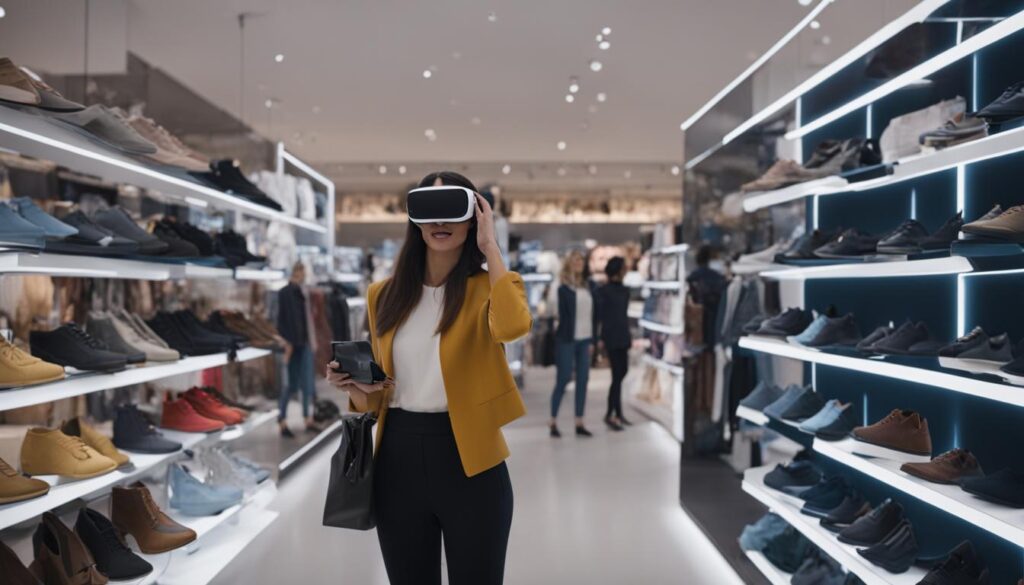We may earn money or products from the companies mentioned in this post.
Shopping has come a long way since the days of brick and mortar stores. With the advent of e-commerce and online shopping, customers have more choices than ever before. However, shopping online lacks the physical interaction that many customers crave when purchasing products. That’s where augmented reality comes in.
Augmented reality in shopping takes the best of both worlds: the convenience of online shopping and the physical interaction of in-store shopping. By overlaying digital images onto the real world, customers can experience products in a virtual environment and make informed purchasing decisions. This technology has the potential to revolutionize the retail industry.
Key Takeaways:
- Augmented reality enhances the shopping experience.
- AR technology is being integrated into retail environments.
- Virtual try-on experiences bridge the gap between online and in-store shopping.
- AR in e-commerce improves the online shopping experience.
- Retailers are embracing AR technology to enhance customer experiences.
The Immersive World of Augmented Reality Shopping
Augmented reality shopping experiences are revolutionizing the retail industry, offering customers a new level of immersion and engagement. Retailers are increasingly adopting AR in their stores and online platforms, recognizing the potential of this technology to enhance the shopping experience.
AR in retail allows customers to interact with products in a whole new way, creating an immersive and personalized shopping experience. Augmented reality shopping apps provide customers with a virtual showroom where they can explore and try on products before making a purchase.
With AR technology, retailers can showcase their products in a way that is visually engaging and interactive. Customers can view products in 3D and from different angles, allowing them to get a better sense of the product’s features and quality.
“Augmented reality shopping experiences provide customers with a new level of engagement and interactivity, making the shopping experience more enjoyable and personalized.”
AR technology also offers retailers valuable data insights, allowing them to understand customer behavior and preferences. By tracking how customers engage with products in AR, retailers can optimize their marketing strategies and ultimately drive sales.
AR in Retail
AR in retail extends beyond just in-store experiences, as many retailers have incorporated AR technology into their online platforms. This allows customers to virtually try on products in their own space, from the comfort of their home.
AR technology is particularly valuable for retailers selling products such as clothing, eyewear, and furniture, where customers may have a hard time envisioning how the product will look in their space or on their body. With AR, customers can see how a product will look and fit before making a purchase, increasing their confidence in their buying decision.
Augmented Reality Shopping Apps
There are a variety of augmented reality shopping apps available in the market, providing customers with a virtual showroom where they can explore and try on products. These apps use AR to superimpose products onto the customer’s real environment, allowing them to see how the product will look in their space.
Some of the most popular AR shopping apps include:
| App Name | Description |
|---|---|
| AR Door | Allows customers to visualize how different doors would look in their home before making a purchase. |
| AR Jewelry Try-On | Enables customers to try on jewelry virtually and see how it will look with different outfits. |
| IKEA Place | Allows customers to see how IKEA furniture will look in their home before making a purchase. |
Augmented reality shopping apps are a game-changer for the retail industry, providing customers with a new level of engagement and interactivity. As AR technology continues to evolve, we can expect to see even more innovative AR shopping solutions in the future.
Virtual Try-On: Bridging the Gap Between Online and In-Store Shopping
Augmented reality shopping solutions have opened up new avenues for customers to interact with products in a way that is more immersive and engaging than ever before. One such solution is virtual try-on, which allows customers to visualize products in a virtual space and try them on before making a purchase. Virtual try-on is a game-changer for both retailers and customers, offering a host of benefits that go beyond traditional shopping experiences.
One of the key advantages of virtual try-on in shopping is that it bridges the gap between online and in-store shopping. With the rise of e-commerce, customers no longer have the luxury of physically trying on products before making a purchase. Virtual try-on brings that experience to the online space, allowing customers to see how products look on them in real-time, from the comfort of their own home.
AR shopping solutions are designed with the customer in mind, and virtual try-on is no exception. By providing customers with a realistic and interactive way to try on products, retailers can increase customer confidence and reduce the number of returns due to improper fit or dissatisfaction with the product. This ultimately leads to increased customer satisfaction and improved brand loyalty.
AR Shopping Benefits for Customers and Retailers
In addition to its role in bridging the gap between online and in-store shopping, virtual try-on offers a range of benefits for both customers and retailers. For customers, virtual try-on provides a more engaging and interactive shopping experience, helping to build a stronger emotional connection to the product. It also allows customers to experiment with different colors, styles, and sizes, making it easier to find the perfect fit.
For retailers, virtual try-on presents an opportunity to differentiate their brand, stand out from the competition, and build a loyal customer base. It also helps to reduce the costs associated with product returns, as customers are less likely to return products that they have virtually tried on. Additionally, AR shopping solutions provide retailers with valuable data insights that can be used to improve product design, inventory management, and customer engagement strategies.
Overall, virtual try-on is a powerful tool in the world of augmented reality shopping. It offers a range of benefits for both customers and retailers, and its potential to revolutionize the shopping experience cannot be overstated.
Augmented Reality in E-Commerce: Enhancing the Online Shopping Experience
Augmented reality has emerged as a game-changing technology that is revolutionizing the way we shop. By blending the digital and physical worlds, AR is transforming the shopping experience, making it more immersive, engaging, and personalized.
In recent years, retailers have been integrating AR into their e-commerce platforms to provide their customers with a more interactive and dynamic shopping experience. AR retail platforms enable customers to visualize products in their own space, using their smartphones or tablets. This functionality allows customers to get a better sense of how a product looks, feels, and fits, without having to physically touch or try on the product.
| Benefits of AR in E-Commerce | Examples of AR Retail Platforms |
|---|---|
|
|
AR retail platforms are driving significant benefits for both retailers and customers. For retailers, AR technology offers a cost-effective and scalable solution for enhancing the shopping experience and driving sales. For customers, AR provides a more engaging and personalized shopping experience, while also reducing the risk of product returns and exchanges.
Overall, augmented reality is transforming the retail industry, providing retailers with new ways to engage with customers and drive sales, and customers with a more immersive and personalized shopping experience.
Emerging Trends in Augmented Reality Shopping
The use of augmented reality (AR) technology in shopping has rapidly increased in recent years, providing retailers with innovative ways to enhance customer experiences. As the AR industry continues to evolve, let’s take a closer look at some of the emerging trends in augmented reality shopping.
AR-Powered Social Commerce
AR-powered social commerce is a game-changing trend that combines augmented reality and social media platforms to create an immersive shopping experience. By using AR filters and effects, brands can showcase their products in a unique and engaging way, encouraging customers to make a purchase. Social media platforms like Instagram and Snapchat are already experimenting with this trend through their AR filters and lenses that enable users to virtually try on makeup, accessories, and clothing.
Integration of AR and AI
The integration of AR and AI is another emerging trend that is transforming the way retailers interact with customers. By combining AR technology with AI-powered chatbots, businesses can offer personalized shopping experiences that cater to the needs and preferences of individual customers. For instance, fashion brands can use AR-enabled chatbots to help customers find outfits that match their style and body type.
AR-Enabled Visual Search
AR-enabled visual search is a trend that simplifies the process of searching for products online. With this technology, customers can use their smartphone cameras to visually search for products, and AR overlays will appear showing them where they can purchase those items. This trend is particularly beneficial for retailers as it provides an additional channel to showcase their products and drive conversions.
AR-Enabled Personalization
AR-enabled personalization is a trend that allows retailers to create unique shopping experiences for every customer. By using AR technology, retailers can offer customized product recommendations based on a customer’s preferences, purchase history, and other relevant data. This trend provides customers with a more personalized shopping experience and encourages them to make repeat purchases.
AR-Enabled Visualization in Real Estate
The use of AR technology in the real estate industry is also an emerging trend that is gaining popularity. With AR-enabled visualization tools, potential buyers can virtually tour properties and visualize how different design elements would look in their intended space. This trend provides real estate agents with a powerful tool to showcase properties to potential clients, and it gives buyers a more immersive and engaging experience.
Conclusion
Augmented reality in shopping has the potential to transform the retail industry by enhancing the shopping experience for customers and providing new opportunities for retailers. As we’ve explored in this article, the immersive world of augmented reality shopping experiences, virtual try-on, and integration into e-commerce platforms are all exciting trends that are shaping the future of retail.
Benefits for retailers
AR technology allows retailers to create engaging experiences for customers, differentiate themselves from competitors, and increase sales by providing customers with a more interactive and personalized shopping experience. By offering virtual try-on experiences, retailers can reduce the number of product returns and increase customer satisfaction. AR technology also enables retailers to gather valuable data insights about customer preferences and behaviors, which can inform future marketing strategies.
Benefits for customers
For customers, augmented reality shopping provides a more immersive and interactive experience that allows them to virtually try on products, visualize items in their own space, and make more confident purchasing decisions. This technology also saves customers time and effort by eliminating the need to physically go to a store or try on multiple products before making a decision.
The future of AR in shopping
As technology continues to advance, we can expect to see even more innovative uses of augmented reality in the retail industry. From improved virtual try-on experiences to enhanced in-store displays, retailers will continue to leverage AR technology to drive sales and improve customer engagement. The potential for AR in shopping is truly limitless and we’re excited to see how this technology will shape the industry in the years to come.
FAQ
What is augmented reality in shopping?
Augmented reality in shopping refers to the use of technology that overlays digital information, such as images or videos, onto the real-world environment to enhance the shopping experience.
How does augmented reality enhance the shopping experience?
Augmented reality enhances the shopping experience by allowing customers to visualize products in their own space before making a purchase. It provides an interactive and immersive experience, enabling customers to try on virtual products, see how items would look in their home, and make more informed shopping decisions.
What are some examples of augmented reality shopping apps?
Some examples of augmented reality shopping apps include virtual fitting rooms that allow customers to try on clothes virtually, home decor apps that enable customers to visualize furniture in their own space, and makeup apps that allow users to try on different cosmetics virtually.
How does augmented reality bridge the gap between online and in-store shopping?
Augmented reality bridges the gap between online and in-store shopping by providing customers with virtual try-on experiences. Customers can see how products would look or fit before purchasing, simulating the in-store try-on experience from the comfort of their own homes.
What are the advantages of using augmented reality in e-commerce?
Using augmented reality in e-commerce enhances the online shopping experience by allowing customers to visualize products in their own space and gain confidence in their purchasing decisions. It also reduces the rate of returns and increases customer satisfaction.
What are some emerging trends in augmented reality shopping?
Some emerging trends in augmented reality shopping include the integration of AR technology in physical retail stores, the use of AR to create interactive product displays, and the development of personalized shopping experiences through AR.
Affiliate Disclosure: This post may contain affiliate links. If you purchase through our link, we may receive a small commission, but at no additional cost to you. For more information, please see our Disclosure statement.



